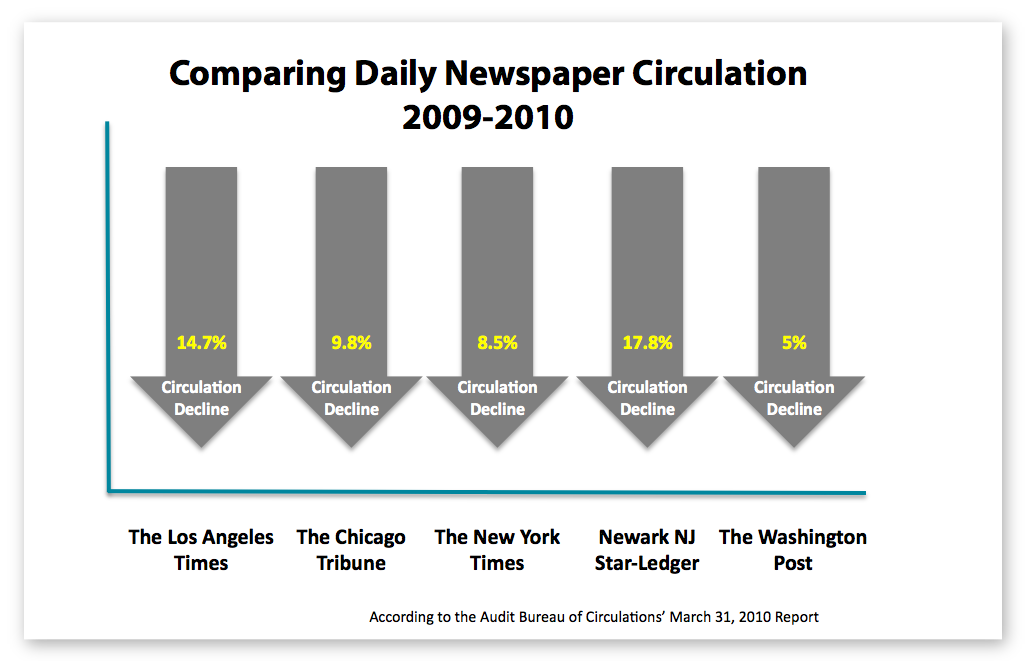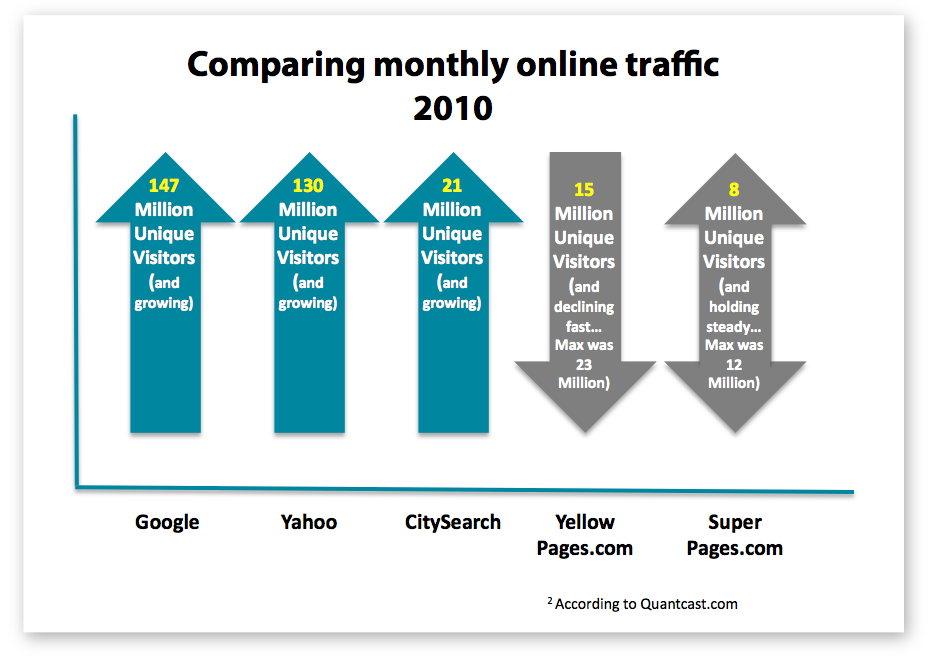We use cookies to ensure that we give you the best experience on our website. By continuing to use this site, you agree to our use of cookies in accordance with our Privacy Policy.
 Login
Login
Your Role
Challenges You Face
results
Learn
Resources
Company
What's happening to newspapers and the Yellow Pages?


Newspapers in decline.
In the first half of 2009, 105 newspapers collapsed, shut down their presses and closed their doors. U.S. newspaper circulation has been dropping by 10%-20% per year. In fact the Audit Bureau of Circulation (ABC) now estimates that less than 30 million Americans buy a daily newspaper. The Washington Post, once a powerhouse media vehicle with well over 1 million daily subscribers, now modestly sells less than 580,000 papers from Monday through Saturday. That publication has fared better than most. Yet they continue to see declines of at least 5% each year.
If people are not reading newspapers, then they are not reading advertisements. And, without question, that severely diminishes your potential to garner a return for your advertising investment.
What about the Yellow Pages?
The first problem with the printed Yellow Pages is that no one uses them anymore. They are perceived as “anti-green”, clumsy, difficult to read, and the ads do not give you nearly enough information to make a value-based decision. It’s no wonder in 2009 alone Yellow Pages revenue declined by 7.5% in the U.S.
In response to these declines, Yellow Pages businesses have attempted to create online marketing “packages”.
Following are the reasons these efforts are failing:
- While monthly traffic is on the rise for Google, Yahoo, Bing and other legitimate search engines, it is declining rapidly for Yellowpages.com and SuperPages.com
- You cannot “own” your campaign, see your analytics reports, nor test multiple landing pages
- Although you will be tied into a year-long commitment, your “campaign manager” could change almost daily
- Your contract will be carefully written with fine print and disclaimers that cover the Yellow Pages, not your business
So what’s a business owner to do?
A comprehensive internet marketing strategy is a necessity in order to survive and thrive in today’s tough business environment. Every day people will search online in your product or service category. And, if they don’t find your business, they will find your competitors.
Search engine optimization (SEO) and a “content” strategy.
While SEO and content strategies are all the rage in message boards and blogs, they take time and effort that many business owners simply don’t have to spare. Every business should, indeed, update their website with the proper metatags, keywords and title tags. And you should create content that is valuable to your target audience. But keep in mind that this type of strategy is like planting seeds in your farm. It will surely deliver a crop but only after several months (or perhaps) years of hard work and lots of patience.
An easier first step.
An internet advertising strategy will generate interest in your business quickly. But to generate leads, sales and a return on your investment, you must do the following:
- Create a landing page or micro-website that provides information and converts an interested internet surfer to a lead
- Test hundreds of keywords
- Test dozens of ads varying copy, offers and incentives
- Place the ads on up to 150 advertising networks (including Google, Yahoo, Bing and others)
- Keep an eye on where and when you get clicks
- Determine which clicks turn into leads
- Pay attention to the leads that turn into sales
Backtrack to tie it all together and maximize your budget.
It is important to backtrack through the entire process. In other words, once a sale has been achieved, you must determine which keywords, which ads, and which offers generated the initial click; and from what geographical location did the lead originate. Also you will want to take note of the day of the week and the time of day the click occurred that ultimately delivered a sale.
By doing all of the above, you will be able to determine where to spend your marketing budget in the coming months. Eliminate keywords and offers that do not turn into sales. Increase your bids on keywords and offers that do. Reduce your spend in geographic regions that do not convert and increase your spend in regions that do. And finally, you will want to increase your bids only during the days and day parts when conversions that turn into sales are most likely to occur.
<<Alert: We’re selling here>>
Sound too time-consuming and difficult? We can help.
- We will make sure your business is seen online
- We will test keywords, ads, landing pages, geographies, days, and day parts to continually refine and maximize your marketing efforts- and deliver a return on your investment
- We offer sales coaching to ensure that every lead is handled right
- We provide detailed reporting
- Your phone will ring and leads will show up in your email inbox while you run your business
Get smarter with the SmartIdeas blog
Subscribe to our blog today and get actionable fundraising ideas delivered straight to your inbox!


